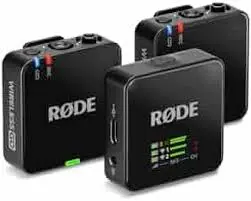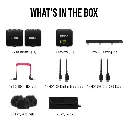Here’s a detailed look at the RØDE Wireless GO (Gen 3) — what it does, what users report, how much it costs in India, and some things to watch out for. If you want, I can also show side‑by‑side comparisons with a couple of alternatives.
🎙 Key Specs & Features
Based on RØDE’s info + Indian retailer listings:
| Spec / Feature | Details |
|---|---|
| System Type | Two transmitters + one receiver (dual‑channel) bodypack system. Wired Tunes+3Tanotis+3curven.net+3 |
| Transmission | RØDE Series IV 2.4 GHz digital wireless, with 128‑bit encryption. Design Info+2urbancine.com+2 |
| On‑board Recording | Each transmitter has built‑in storage and supports 32‑bit float backup recording (usable to “rescue” clipped or very quiet signals). Up to ~40 hours of float‑format recording. Tanotis+3Design Info+3curven.net+3 |
| Range | Up to 260 m (≈ 853 feet) line‑of‑sight between TX ↔ RX. Indoors / with obstacles, performance will drop. Tanotis+2aabworld.com+2 |
| Battery Life | ~7 hours on transmitter/receiver in typical usage. (Charging via USB‑C). Design Info+2Tanotis+2 |
| Audio & Output | Built‑in omnidirectional mics; locking 3.5 mm input jacks on the transmitters for external lav mics; the receiver has analog 3.5 mm outputs and USB‑C digital output. Design Info+2Wired Tunes+2 |
| Features | • Intelligent GainAssist (auto level adjustments) • Safety channel • Bright display showing levels, battery, RF status • Universal compatibility (phones, cameras, computers) • Included cables: SC2‑type etc., carry pouch, windshields etc. Tanotis+3urbancine.com+3Design Info+3 |
👍 What It’s Good For
Great for interviews, dual vlogging setups (two people speaking), since two transmitters are included.
The 32‑bit float on‑board recording is very helpful — if you mis‑judge the levels (too loud or too soft), this format lets you recover audio more easily.
Wide range (in ideal conditions) gives flexibility in outdoor shoots or where the subject may move around.
Very useful for users who switch between devices (phone, camera, computer), thanks to multiple output options.
The locking 3.5 mm inputs are a plus if you want to use external lavaliers for better discretion or mic quality.

⚠️ Things to Be Careful About / Limitations
Real‑world range is often much less than the “260 m” spec when there are walls, RF interference, or other obstacles. Don’t expect best‑case spec indoors.
Battery life is decent but using all transmitter features (e.g. external mics, loud sound, USB‑C powering etc.) will reduce usable hours. Always have backup charging.
Omnidirectional mic capsules: they pick up sound from all around, so in noisy / reverberant environments you’ll still capture unwanted ambient or background noise. Mic placement and environment treatment matter.
USB‑C / cable compatibility: sometimes the cable you use (or adapter) may affect whether audio is accepted properly. Make sure to use good quality cables and update firmware. Reddit+1
Price is on the premium side; for many use‑cases, you may get acceptable audio from lower‑cost systems if you're okay with fewer features.
%20%E2%80%93%20Compact%20Wireless%20Mic%20%E2%80%93%20Pristine%20Audio,%2032-bit%20Float%20Recording,%20Automatic%20Level%20Control,%20for%20Phones,%20Cameras%20and%20Computers?unique=4467dd4)






%20%E2%80%93%20Compact%20Wireless%20Mic%20%E2%80%93%20Pristine%20Audio,%2032-bit%20Float%20Recording,%20Automatic%20Level%20Control,%20for%20Phones,%20Cameras%20and%20Computers?unique=4467dd4)





